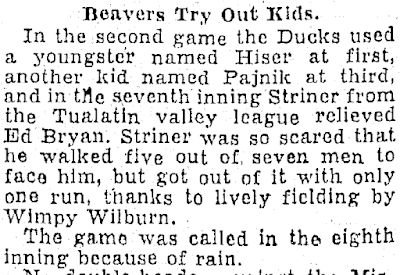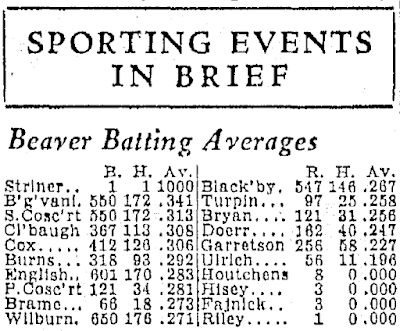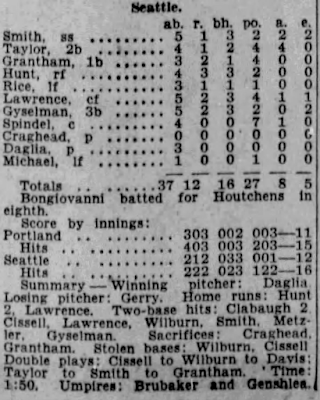Highly touted prospects that ultimately don't end up panning out is nothing new in baseball. It's been happening for a long time, and will probably continue to occur for as long as the sport itself exists. Often times, it'll be many months, and even more frequently, years, before teams will realize, or at least publically admit, that their great find didn't live up to the lofty expectations that were place upon them. It's quite a bit rarer though to come across a player who goes from potential future star to just another name in the telephone directory in a little over a month. Today's post features just such a player.
 |
| Morning Register 3/10/28 |
 |
| Oregon Journal 3/8/28 |
Despite being signed right at the beginning of spring training, articles, or even mentions, of Orlin's progress are pretty scant after the initial hype of his find; though everyone did seem to be in agreement about the high likelihood of his being with the club during the upcoming season.
 |
| Oregonian 3/19/28 (Photo of Orlin Berry, on the right) |
On March 27th, The Oregon Daily Journal reported that Orlin is "bothered by his back and was given a rest".
Another hearty indorsement from Orlin's "discoverer", veteran Guy Cooper, appeared in the April 1st edition of The Los Angeles Times, in which he describes the youth as having "proper size as a catcher, a good throwing arm, hitting ability and the correct temperament". He did add a little bit of a caution though when he said "There are so many factors to be taken into consideration, however" and "that only his tryout will really tell". This article also refers to Orlin as the former Harding High School player, and also mentions, again, that Guy Cooper fist saw Orlin playing for the Sawtelle semi-pro team (more on that below), hence my belief that Orlin had indeed graduated high school the year before.
Orlin must've passed muster during Spring Training as it was reported by The Oregon Daily Journal on April 15th that he would be with the team when they opened up the season in two days.
Previewing the Beaver's upcoming season, the April 19th edition of the Santa Cruz Evening News mentions that Portland has little to worry about at the catcher position, as Tony Rego was back to do the bulk of the work, and if he needs a rest, the team has also just acquired Eddie Ainsworth to back him up. And bringing up the third string, Orlin Berry, "a hustling kid, who has convinced [manager Ernie] Johnson that he should be carried through the season". Then, just nine days later...
 |
| The Sacramento Union 4/28/28 |
It's a rather abrupt ending, but this was the last of the "Orlin Berry experiment", for lack of a better term, as far as the Portland Beavers were concerned. And despite his youth, and apparent potential, it appears that this was also Orlin's only foray into one of the higher class leagues.
There isn't a lot of information available online about Mr. Berry's life post (or even pre for that matter) Beavers, but I have been able to gather enough for an abbreviated biography:
Orlin Vliet Berry was born in Highmore, SD on September 15th, 1909. His family moved briefly to Peoria, ILL, sometime in the 20's, before going west to settle in the Los Angeles area while Orlin was in high school. His dad, Laurel, was also a catcher at some point, presumably back in SD, though I've not been able to find any records of his involvement with any particular team (amateur and semi-pro games can be terribly hard to find coverage of depending on the time and place in which they occurred).
Two different articles shown above mention Orlin's having been playing with Soldiers Home at the time of his discovery, which is corroborated by his Sporting News Contract Card.
There aren't very many box scores featuring Soldiers Home online, but of the few available from 1928-1930, there's an "A. Berry" listed as catcher, who I'm assuming was Orlin.
The 1930's saw him getting married and having a child. There are two newspaper mentions during the mid 30's of an Orlin Berry singing at a wedding, and performing with a group. Whether this was a brief career, or just a hobby, I do not know, as according to the 1940 census he was now a laborer at a picture studio. By 1950, he had moved up to labor foreman in presumably the same "motion picture studio". Despite much searching, I could not find out which studio though. His passing in 1969 (no obituary) at the age of 59 is the last piece of public information about him after 1950.
Technically speaking, Orlin Berry never was a Portland Beaver, but even so, I find him to be one of the more interesting prospects in Beavers history; if only because there's still so many unanswered (unanswerable?) questions surrounding his brief association with the team. As per usual, I will continue to look for new information from time to time, and will come back and update this post if anything new does become available.

.png)
.png)

























